![]()
|
Frederick
Winkle & Co |
|
Location and period of operation:
|
F Winkle
& Co |
Stoke |
1890 |
1931 |
Earthenware manufacturer at the Colonial Pottery, Whieldon Road, on the border of the pottery towns of Fenton and Stoke, Stoke-on-Trent, England
|
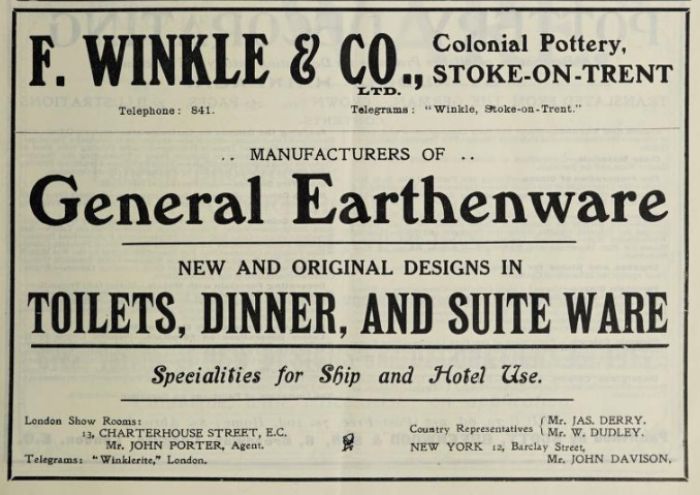
F. Winkle & Co Ltd
Colonial Pottery, Stoke-on-Trent
Manufacturers of General Earthenware
New and Original Designs in
Toilets, Dinner, and Suite Ware
Specialities for Ship and Hotel Use
The Pottery Gazette - 1st January 1913
|
VERSAILLE is the pattern name |
photos courtesy: Oak Leaf Antiques.
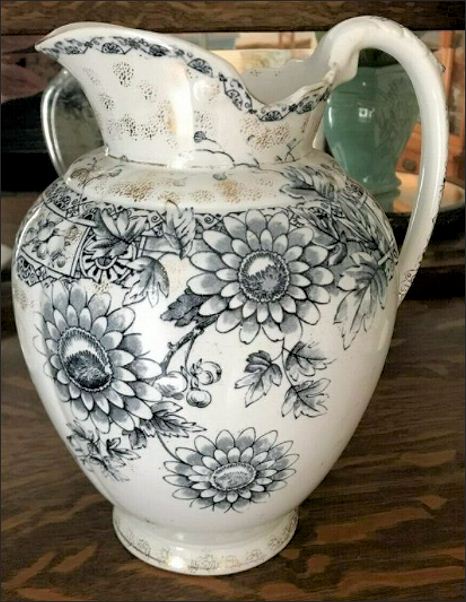 transferware jug in an aesthetic style pattern |
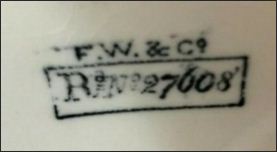 F W & Co the registration number 27608 shows that the pattern was originally registered on the 30th May 1885 to Wood, Hines & Winkle at the Pearl Pottery, Brook Street, Hanley |
c.1890
Fenton Faience
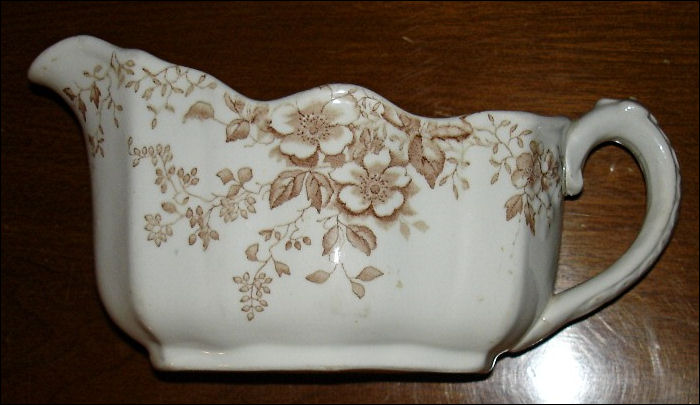
'Fenton Faience' - a sauce boat in the Surrey pattern
|
"FENTON FAIENCE" is a trade name that F. Winkle introduced in 1891 as a marketing tool. FENTON from the location of the pottery works in the pottery town of Fenton and FAIENCE after the popular European tin glazed earthenware. There were two patterns, Severn and Surrey, marketed under this trade name - both were registered on the 15th October 1891 making them amongst the earlier patterns registered by F Winkle & Co. Most of the ware in the Severn and Surrey patterns were brown printed on everyday dinner and tea sets. Occasionally the patterns were hand coloured and appeared on decorative items. |
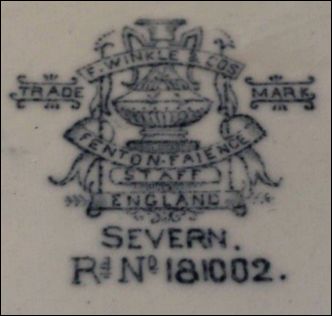 Severn Rd No 181002 The Severn pattern consists of a trailing plant with spiky leaves and five petal blooms |
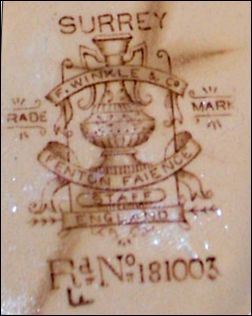 Surrey Rd No 181003 The Surry pattern has
trailing sprays of dog roses with leaves and flowers |
F Winkle
& Co
Trade Mark
Fenton Faience
Staff
England
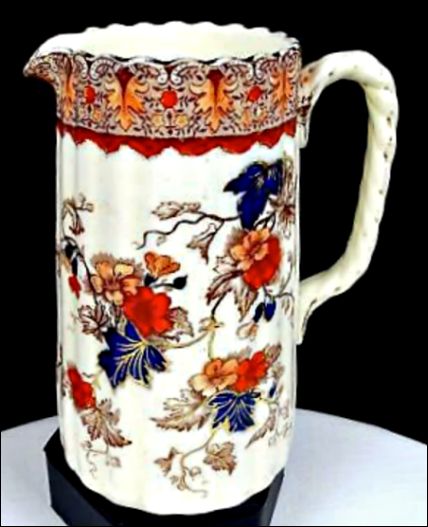 'Fenton Faience' hand coloured jug in the Severn pattern |
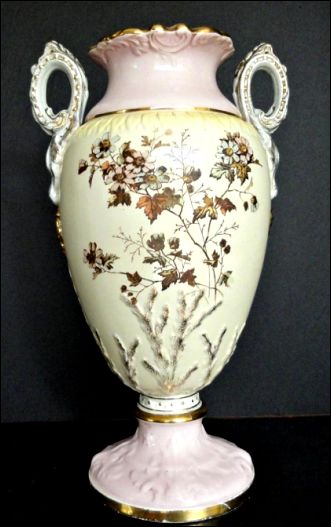 'Fenton Faience' vase with a painted background in the Surrey pattern |
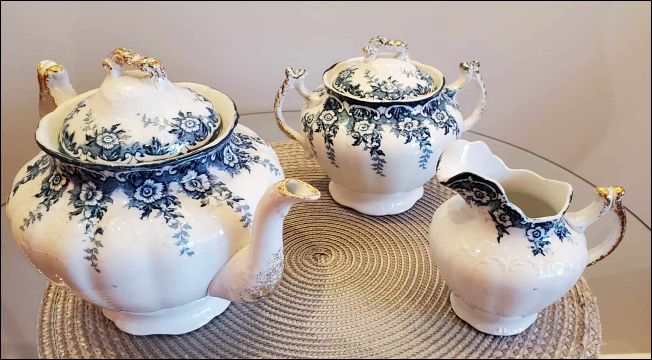 tea set in the Matlock pattern - transferware with gold accents |
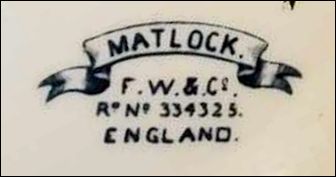 F W & Co ENGLAND the registration number 334325 shows that the pattern was registered on the 24th February 1899 |
photos courtesy: Clea Reynolds
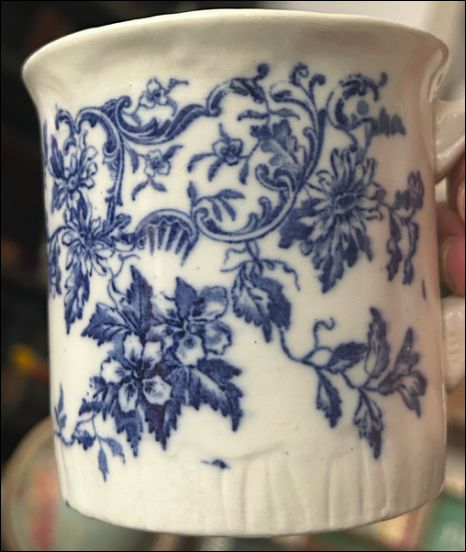 transfer decorated mug in the Shelly pattern |
c.
1890-1910 |
photos courtesy: Jen Knodell
|
this pattern was based on the very popular blue & white Asiatic Pheasants pattern |
Semi-Porcelain c.1908-11 The circular 'Whieldon Ware' mark was introduced in 1908 and continued until 1925. Generally after 1911 the '& Co' was replaced by '& Co Ltd' |
photos courtesy: Kathy Rae
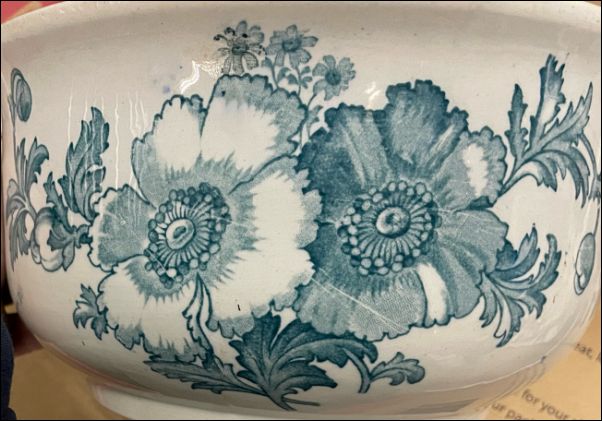 transfer decorated chamber pot in the Kingston pattern |
1911-1925 |
photos courtesy: Justin Gentle
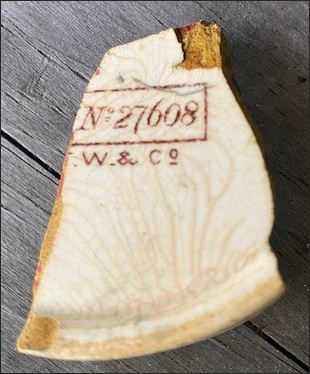
fragment bearing the F. Winkle & Co mark found
on the beach at North Haven Island, Maine, USA
the registration number 27608 shows
that the pattern was originally registered
on the 30th May 1885 to Wood,
Hines & Winkle at the Pearl Pottery, Brook Street, Hanley
photo courtesy: Kaitlyn Kirby
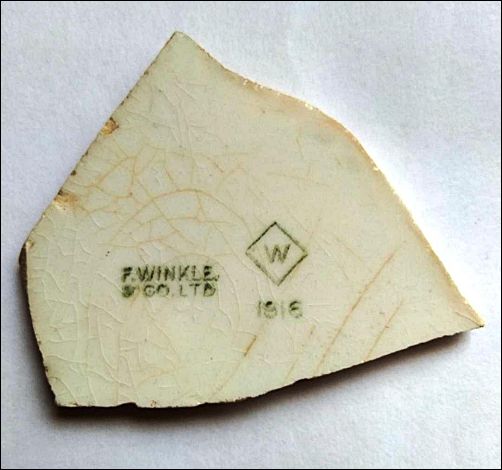
F. Winkle
& Co Ltd
W
1916
|
Shard found on the beach in Whitby, Yorkshire, England [2023] The ware shown was produced for and supplied to the British Government; it was ultimately property of the Crown/Government. F. Winkle (and others) were given government contracts throughout the late 1900s (WWI) and produced canteen ware - most likely for the armed services. The ‘W’ within the diamond relates to the products being commissioned and produced for the Office of Works. This mark is there to distinguish the piece from being normal ‘utilitarian’ ware for public sale or belonging to anyone organisation. |
photo courtesy: Tim Cooper
Marks & initials used on ware for identification:
F W & Co
ENGLAND
F WINKLE & CO
WHIELDON WARE
Winkle used the
trade name 'Whieldon Ware'
after the name of a famous 18th Century
potter Thomas Whieldon who
lived and worked
in this area.
The road that Winkle's Colonial Pottery was
situated on is called Whieldon Road
|
c. 1890 |
1891-1911 |
1908-1911 |
the circular 'Whieldon Ware' mark was introduced in 1908
generally 'Ltd' was added after 1911
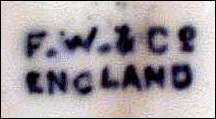 F. W. & Co England |
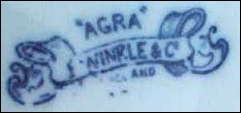 F.Winkle & Co England |
1890-1910
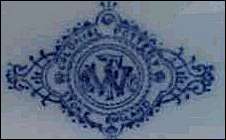 Colonial Pottery F. W. & Co Stoke England |
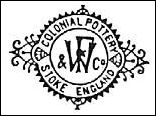
1890-1925
|
|
1908-1925 this
circular mark is usually accompanied by other marks Winkle used the
trade name 'Whieldon Ware' The road that Winkle's Colonial Pottery was |
|
1908-1911 |
1911-1925 'Ltd' was added after 1911 |
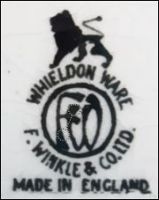
Whiledon Ware
FW
F. Winkle & Co Ltd
Made in England
1925-1931
The factory was situated alongside the Trent and Mersey canal
In the foreground is Whieldon Road.
- click for more on the Colonial Pottery -
![]() 1893 trade
journal article on Winkle
1893 trade
journal article on Winkle
| Related pages..
Mount Pleasant! The very name evokes Englishness with a tinge of Norman chivalry sufficient to enchant the imagination back to baronial times, castle-keeps and sheriffs, pastoral landscapes, parish lore, and village peace. Grove Road, Heron Cross, Great Fenton
- Early potters walked the track from Lower Lane to Lane Delph: Thomas Whieldon 1719-1795 a Master Potter who influenced and taught the famous potters Ralph & Aaron Wood and Josiah Spode. He was in partnership with Josiah Wedgwood.
|
Questions, comments, contributions? email: Steve Birks